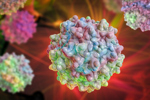FEATURED EDITORIAL
Following positive results from a Phase 1b trial, company leaders describe scaling their yeast expression and spray-drying processes as they prepare for Phase 2.
- Understanding FDA's New National Priority Voucher Pilot Program
- The Latest Techniques And Technology For Differentiating Capsids
- Smarter CDMO Engagement with AI In Biologics And Cell & Gene Therapy
- AI-Assisted QMS: Bridging ISO/IEC 42001:2023 And ICH Q10 For Pharmaceutical Excellence
- Navigating FDA Regulatory Changes: Policy Shifts, Deregulation, Restructuring, And Future Oversight
- Ask The Pros — The Latest In Downstream HCP Mitigation
- Understanding FDA's Draft Guidance: Composition Statements Of Ingredients In Labeling In NDAs And ANDAs
GUEST COLUMNISTS
-
The Latest Techniques And Technology For Differentiating Capsids
Since AAV gene therapy’s origins, scientists and regulators have sought optimized ways to measure empty/full capsids. This expert reviews pros and cons of modern methods.
-
Smarter CDMO Engagement with AI In Biologics And Cell & Gene Therapy
In biologics and cell and gene therapy (CGT), selecting and managing a CDMO has become a strategic imperative. Unfortunately, traditional approaches to external partners can fall short. But now AI is reshaping this landscape. Analysis from an Outsourced Pharma Board member.
-
AI-Assisted QMS: Bridging ISO/IEC 42001:2023 And ICH Q10 For Pharmaceutical Excellence
Integrating AI into quality management systems (QMS) can be a transformative opportunity to enhance quality assurance, improve compliance, and enable proactive risk management.
-
Navigating FDA Regulatory Changes: Policy Shifts, Deregulation, Restructuring, And Future Oversight
Recent shifts within the U.S. FDA reflect an increasingly complex tension between scientific rigor and accelerating political and economic pressures. Here are the newest developments and emerging focal points.
-
Ask The Pros — The Latest In Downstream HCP Mitigation
Two downstream biologics processing experts address some of the field's complex, nagging questions about mitigating host cell proteins.
-
Understanding FDA's Draft Guidance: Composition Statements Of Ingredients In Labeling In NDAs And ANDAs
The FDA's 2024 draft guidance details presentation of a drug product’s composition and the corresponding details of the ingredients in the product labels for NDAs and ANDAs.
-
How Is RIM Software Transforming Regulatory Compliance?
Regulatory information management (RIM) software tools streamline global regulatory processes on a single cloud-based platform throughout the entire product life cycle.
-
EMA Guideline On Clinical-Stage ATMPs Comes Into Effect: On The Verge Of Convergence?
The EMA’s Guideline on quality, non-clinical and clinical requirements for investigational advanced therapy medicinal products in clinical trials came into effect on July 1, 2025
PHARMA OUTSOURCING WHITE PAPERS
-
Maximizing rAAV Production Efficiency: Introducing Pro10™ Cell Line
This HEK293-derived, animal component-free suspension cell line forms the foundation of a scalable, robust platform process that accelerates AAV manufacturing.
-
Three-Dimensional Linkage Analysis With Digital PCR For Genome Integrity
A cost-effective approach with a comprehensive AAV analytical package holds the potential to advance the application of rAAV in cell and gene therapy for the treatment of human diseases.
-
A Shift Towards Biofluorescent Particle Counters In Manufacturing
Sterility in injectable drug manufacturing is vital for patient safety and efficiency. Discover how biofluorescent particle counters revolutionize contamination control, regulatory compliance, and operational excellence in modern pharma.
-
Driving Operational Excellence Using Machine Learning
Explore how advanced machine learning and data analytics are revolutionizing biopharmaceutical manufacturing and driving operational excellence.
-
Manufacturing Challenges With High Concentration Biologics
Explore key process operations, some of the challenges in manufacturing high-concentration biologics, and factors to consider for process optimization.
-
Development And Regulation Of Veterinary Monoclonals
Although veterinary mAbs have achieved commercial success, ongoing discussions and clinical developments surrounding them are expected to outline a clear regulatory pathway in the near future.
PHARMA OUTSOURCING APP NOTES & CASE STUDIES
- Characterization Of Host Cell Proteins By Liquid Chromatography - Mass Spectrometry
- How To Unlock The Secret To Repeatable, Scalable Low Turnover
- Aseptic Filling Solution Enhances Sterility Assurance for Pharma Manufacturer
- Novel Engineered Plasmids, Optimized HEK293 Cell Line For AAV Productivity
- A Pre-Clinical Study For Diet-Induced Obesity
NEWSLETTER ARCHIVE
- 06.30.25 -- Helpful Biosafety Testing Innovations For mAbs Development And Manufacturing
- 06.30.25 -- STREAM Edition: When Outsourcing, Take Advantage Of Each Other's Strengths
- 06.30.25 -- Lonza Bets The House On Biologics. What's It Mean For You?
- 06.27.25 -- How A Biotech Navigates The CDMO Frenzy For GLP-1 Services

REPORTING: TRUMP VS. PHARMA?
- Tariffs On Toys … And API? Biopharma As The Next Battleground
- Evolve Or Fade Away? Biotech's Outsourcing Moment In Trump's Tariff Tangle
- Lilly's CEO Building On The Trump Agenda
- Tariffs Won't Stop Drug-Candidate Licensing From China Biotechs
- CDMOs Bet Big On Asia Expansion. Can Trump Reverse The Tide?
- What If The Trump Tariff Strategy Works?
REPORTING: U.S. BIOSECURE ACT
PRODUCTS & SERVICES
ON-DEMAND WEBINARS
- Closed Sampling: Crucial For Aseptic Processing
- The Pathway To Operational Readiness
- Navigating The New USP Chapter <382> For Elastomeric Closures
- Streamlining Drug Development: From Developability Assessment To High-Concentration Formulation Development
- UpTempo℠: Seamless Transitions From Bench To CGT Applications
























